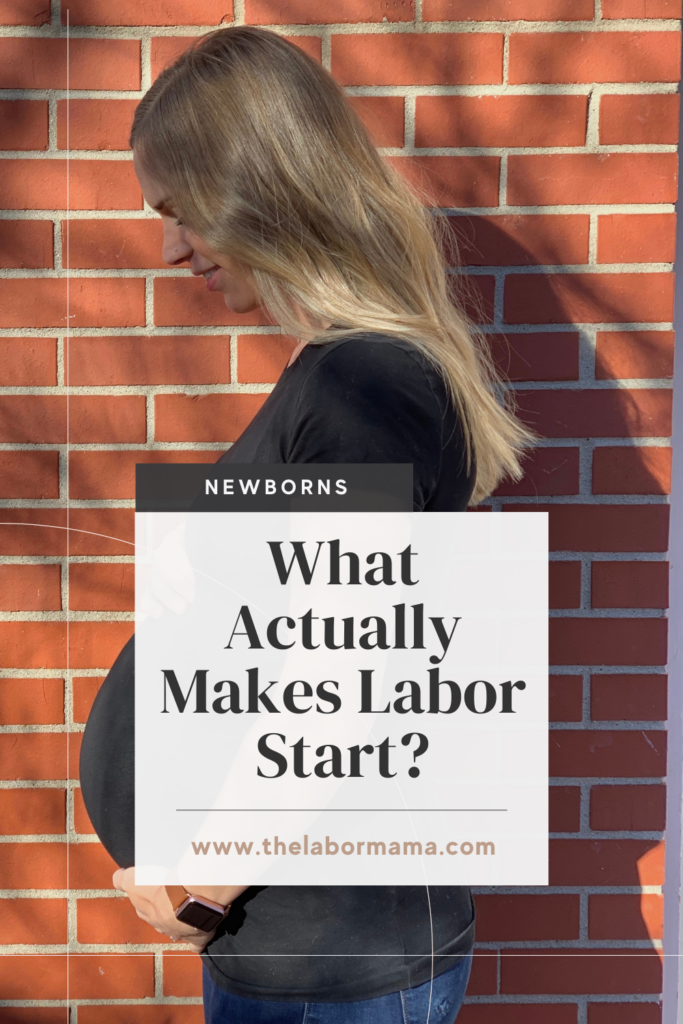Are you 38 weeks pregnant, feeling so very ready, and sitting over there wondering what actually makes labor start? It’s THE million dollar question, isn’t it? And to be honest (you probably already know this), no one fully knows. But there are some interesting theories to consider – and I have some suggestions for you about what you can actually do while you wait for your little to make their grand entrance.
Who is The Labor Mama and Why Am I Here?
Hey friend! I’m Lo – also known around here and social media as The Labor Mama. I’ve spent my nursing career in labor, delivery, and postpartum, have birthed 4 of my own babies, have labored thousands of mamas at the bedside, have taught hundreds of students online, and have even delivered a few speedy little babies with my bare hands (oops).
Here at TLM, I offer online classes to empower you the way everyone should be. The education + support I offer gives you experience, evidence, and empathy; you’re getting all of my years of “clinical” RN knowledge, beautifully combined with my real experiences as a mama and a nurse. These are not your average hospital classes (those won’t do it, I promise), and honestly, birth, postpartum, and breastfeeding don’t follow a textbook or protocol anyway. You need to know so much more than that!
If you want to connect with me further, head to Instagram. There are hundreds of thousands of us over there learning together daily.
A note: This post may include affiliate links. This means if you make a purchase after clicking a link, I will earn a small commission (thank you)! Rest assured, this comes at no additional cost to you. You can read TLM’s full disclosure here.

Will you be pregnant forever?
I know that you know you won’t be pregnant forever, but seriously, the end of pregnancy can feel so long, right? I’m sure you’ve heard those funny “The average pregnancy is about 9 months long, the last month of that is 187 days” quotes? They always make me laugh; that last month really can both fly by in a blink and totally drag.
How long is pregnancy actually supposed to be?
Pregnancy dating is an interesting little science, and one that not everyone fully grasps. When someone tells you pregnancy is 9 months, they’re often talking about typical calendar months. And you know that those months are usually 30-31 days long, right? But when it comes to due date dating, you really want to be thinking about weeks, and drop the months mentality completely!
You will often hear that the average length of pregnancy is actually 280 days long. This is a description of weeks, not months; so the average length of pregnancy is 40 weeks (280/7 = 40). And why is that important? Because our calendar months are all 4 weeks and some change (2-3 days, depending on the month), so the math related to “months of pregnancy” just doesn’t make sense.
Here’s another consideration, too. The American College of Obstetricians and Gynecologists states:
“Pregnancy is counted from the first day of your last menstrual period. This means an extra 2 weeks are counted at the beginning of your pregnancy when you aren’t actually pregnant. So pregnancy lasts 10 months (40 weeks)—not 9 months—because of these extra weeks.”
Do you see how ACOG says 40 weeks = 10 months? That’s because pregnancy “months” are related to a 28-day cycle. To be honest, in my opinion, ACOG’s use of the word months is still confusing. Our calendar months are not actually 28 days long, so why are we trying to define pregnancy in months? I wish they would just say, “so pregnancy lasts 40 weeks” – and that the rest of the world would stop using the confusing 9 month terminology too.
Is your due date right?
Want to know something else really interesting about length of pregnancy? There is a good amount of research that shows that many due dates are actually off by 3-5 days! Some 2001 research found that:
- About half of first time mothers will go into labor by 40 weeks and 5 days
- About half of repeat birthers will go into labor by 40 weeks and 3 days
The length of labor predictions are based off of something called Naegele’s Rule, which uses a standard 28-day cycle to predict the length or pregnancy. This rule assumes a “normal” 28-day cycle and a 280 day pregnancy for everyone – young or old, first baby or sixth baby, Caucasian, Asian, African, Indigenous…you get the picture? It just doesn’t make a lot of sense – and evidence shows that it really isn’t logical!
Ultimately, what I hope you are hearing is that you really should hold that due date loosely. The actual length of pregnancy is an imperfect science, and it’s also true that babies can show up over a range of about 4 weeks of time and it’s all totally normal.

Ready to pack your hospital bag? You can snag my packing checklist here. If you want to read more about what I actually think you need to pack, you can find that here.
When will your baby be born?
Like I said when we started, we just don’t know what actually makes labor start (and pregnancy end)! But one thing that is very certain is that there there are a lot of hormones at play in this dance. It’s also important to point out that there isn’t just one thing that happens – it’s very likely some sort of whole cascade of events. Let’s talk through three common or popular “theories.”
01. Elevated levels of oxytocin
The first theory is related to the secretion of oxytocin from the maternal pituitary gland. Oxytocin is a naturally occurring hormone that rises throughout pregnancy. It stimulates uterine contractions and also plays a role in bonding and breastfeeding. It’s believed that at some point, maternal plasma oxytocin hits the level it needs to and triggers contractions. When those contractions coincide with a ripe cervix, labor ensues.
02. Fetal lung proteins
There is also a theory about the baby actually being the thing that triggers labor. There is research that shows that when baby’s lungs are fully mature, they release a certain protein (surfactant protein A (SP-A)) that then triggers a prostaglandin wave in the maternal body that triggers labor to begin. Prostaglandins are a hormone-like substances in the body that play a lot of different roles. In labor and brith, they help ripen the cervix and may lead to uterine contractions. During labor inductions, your care team may also suggest the use of synthetic prostaglandins to begin the labor process.
03. Elevation of cortisol
The third theory related to the baby’s adrenal glands. Around 38-40 weeks of pregnancy, a baby’s adrenal glands begin functioning similarly to an adult. They can release cortisol, which might interrupt the balance of progesterone and estrogen in the pregnant body, and labor begins.
This theory is far from proven to be true though! Researchers have also noted that though some studies have shown higher levels of fetal cortisol after spontaneous labor as compared to induced labor, it has not been possible to determine if the higher levels were what caused labor or if they were a consequence of labor.
How can you make labor start?
Like you can see from these theories, there is so much we don’t know. And also? You just aren’t really in charge of any of this! Knowing that, the question is then: “What can you do while you wait for labor to start?” That conversation is HUGE, but I’ve included a list below of things that many try or do to encourage labor to start.
I’d also love to take the chance to remind you that bodies go into labor when they’re ready – so don’t wear yourself out too much in the weeks before your due date. You know now that our due dates are really a big, loose range, and there isn’t a huge point of wearing yourself out doing all the things in the weeks leading up to that due date.
How to get labor to start
- Inversions
- Open knee chest
- Birthing ball use (Figure 8s and hip circles)
- Psoas muscle stretches
- Side lying release
- Chiropractic adjustments
- Miles Circuit
- “Natural” induction methods
- Membrane sweeps
- Nipple stimulation
- Eating pineapple
- Raspberry leaf tea
- Sex
- Spicy foods
- Castor oil
- Midwives Brew
- Primrose oil pills
- Dates
The “natural induction” conversation is VERY big, so I dedicated an entire module in my birth course, Your Body, Your Birth, to it. Are you already a student? See Module 5! If you aren’t a student yet, I’d love to have you join me.
The takeaway on what actually makes labor start
Ultimately, we just don’t know why the body does or does not kick into labor. What most will say is that the process is some sort of dance between baby and mama and that there are inputs coming in from both bodies! When possible, most would agree that it’s best to let labor begin on its own, and give all of these processes and hormone their chance to do their thing. If you are interested in the things you can do at home to encourage labor, join my on IG, where I teach about that often! It’s also important to have that conversation with your provider, so they can give you the go ahead for whatever things appeal to you.
Did you try anything to get labor going? Do you think it worked or helped? Let me know in the comments! xx – Lo
More reading to take a look at:
More resources (and freebies!) for you to take a peek at:
- Comprehensive Birth Plan and Birth Priorities templates
- A complete Third Trimester Checklist
- The RN + mama of 4 Ultimate Packing List
- The Labor Mama online birth, baby and breastfeeding classes for every family




